Tips for spotting fake sourdough bread at the store so you don’t waste your money on a phony product that is an unhealthy choice.
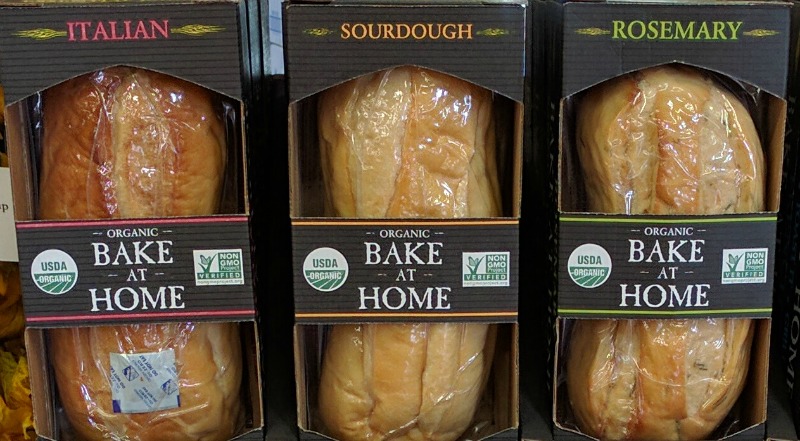
As awareness of the benefits of sourdough bread increases, so does the potential for food manufacturers – both large and small – to exploit the term.
And exploit it they most certainly do!
I recently examined every single loaf of bread at a local health food store. I found only one out of over half a dozen that claimed to be “sourdough” that was leavened in a traditional manner. No, it wasn’t The Essential Baking Company sourdough bread in the picture above. You won’t believe what this company is doing to fool consumers. Even I was shocked, and I thought I had seen it all.
If you choose to buy instead of making sourdough bread yourself (yes, it is a bit time-consuming!), then be on the lookout for fake sourdough!
It is literally everywhere!
Spotting phony sourdough is a more difficult process than you might think due in part to the sourdough myths that seem to abound.
When I first set out to write this article, I thought it would be fairly straightforward to explain. As it turns out, spotting a fake sourdough is rather tricky due to unethical food manufacturer tactics that are far sneakier and devious than I ever imagined.
You really need to be on your toes when sourcing sourdough bread to ensure that you aren’t wasting your money on a product you thought was a healthy choice for your family, but in fact, was quite the opposite.
If you use reading glasses, be sure to always bring a pair with you into the store so you can read the fine print on the packaging. If you wait until you get home to take a look, chances are you are going to be disappointed.
Fake Sourdough Masquerading as Real
The picture above shows one of the most popular fake sourdoughs on the market as of this writing. I was asked to take a look at it by a reader who thought it was legit. This brand is available at many health food stores. At my local Whole Foods, it is very prominently placed with an attractive display right near the checkout lines.
Some folks have notified me that it is also available at Sam’s Club and Walmart mega-supermarkets too!
Notice how the company has taken great care to appeal in every way to the health-conscious, time-challenged consumers:
- The loaf is clearly labeled “Sourdough”.
- The USDA Organic certification is front and center on the box.
- The NonGMO Verified label is prominently shown.
- The term “Bake at Home” is used to catch the eye of time-strapped consumers, some of whom WANT to provide fresh-baked sourdough for their family, but just don’t have the time.
I give this label a 10 out of 10. Fantastic marketing that is sure to move those boxes off the shelf like hotcakes. It’s even priced like a real sourdough would be at $6+/loaf where I live.
Watch Out for Ingredients Listed on the Box vs Online
Here’s the sneaky part. The ingredients on the label of this phony sourdough are DIFFERENT than what is on the website. Yes, the company has obviously done its research. Consumers are increasingly checking out products online before buying.
Don’t fall for this trick. Below is an online screengrab from December 28, 2016, of the ingredients for this company’s “sourdough” bread:
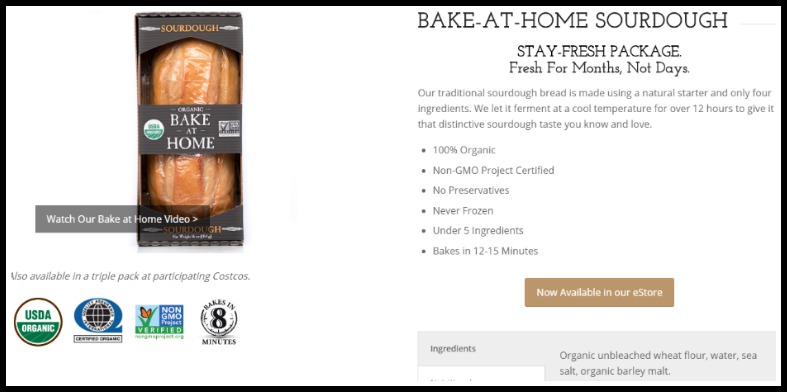
Notice the ingredients say: organic unbleached wheat flour, water, sea salt, organic barley malt.
To semi-researched consumers who know enough about sourdough bread to understand that it never contains yeast, this is enough information to fool them and get them to buy.
Take care not to be easily fooled, however! Look what I found when I looked at the actual label of this very same sourdough bread at the store. Check out the photo below taken on the very same date – December 28, 2016.
The exact same sourdough bread has YEAST listed on the box!
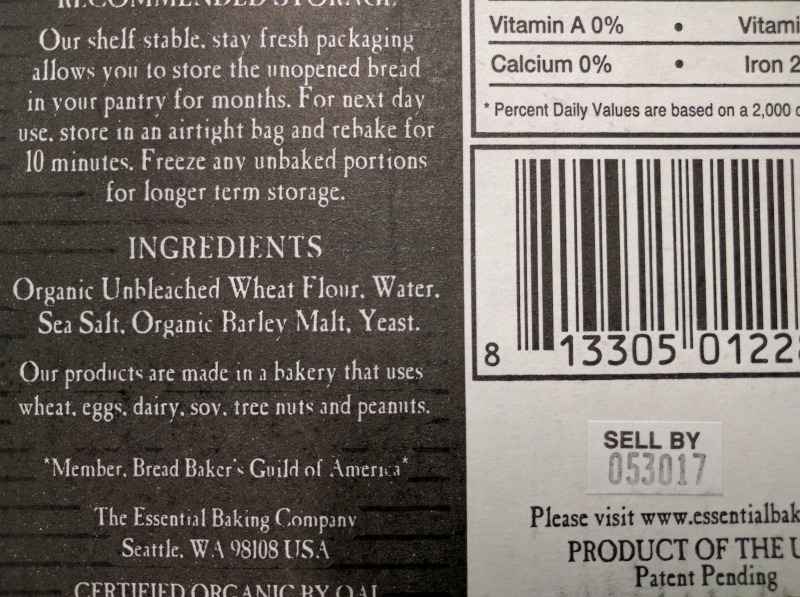
This is a new tactic I have not been aware of before … listing different ingredients for a product online versus what is on the label. Online it states “under five ingredients” using a “natural starter” with the bread “fermented” at a cool temperature for over 12 hours. The box at the store, however, lists 5 ingredients and the “natural starter” turns out to be yeast, which is most decidedly unnatural when it comes to sourdough! Other problems with this bread include the use of sweetener (organic barley malt) and white flour.
If a product seems too good to be true, it probably is.
I mean, seriously? Would an authentic sourdough come in a convenient “bake at home in 12-15 minutes” package that is shelf-stable for nearly 6 months?
Absolutely not!
The short video below summarizes the issues and how to spot the good stuff.
Authentic Labels
The label of true sourdough bread is going to list sourdough starter instead of yeast in the list of ingredients. For example, the gluten-free sourdough bread I buy from a local bakery has “cultured brown rice flour” listed as the starter.
The wording for the sourdough starter varies from brand to brand.
However, there will usually be some indication of a cultured starter as the leavening agent.
This starter contains natural beneficial yeasts from the environment rather than processed baker’s yeast which increases baking speed and baking temperature.
This is important because naturally leavened bread is more digestible, nutritious and less likely to trigger allergy problems than modern, yeast rise bread.
Ultimately, the consumer really must take the time to ensure that the sourdough bread of their choosing really is what it claims.
The Sourdough Bread I Buy
Real sourdough bread is so difficult to find that I’ve resorted to shipping freshly baked sourdough direct from the bakery to my door.
The bakery I use is Organic Bread of Heaven and I order the Rustic Sourdough. I ship in six loaves at a time and freeze what I won’t use in 4-5 days. They also have sourdough bagels, tortillas, hamburger buns, and English muffins among other authentic items.
Free shipping is available for orders over $49 (ask a friend to jump in with you!). The price is several dollars cheaper per loaf than the bread at the health food store.
To give it a try, use coupon HEALTHYHOME (all caps) for 10% off your first order.
Even if you pay shipping by ordering just a few real sourdough loaves, the price per loaf is still comparable to the fake sourdough at the health food store!
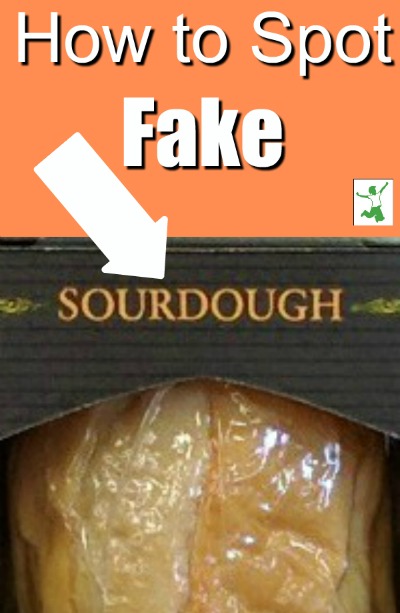
Rules of Thumb
Here are some rules of thumb to identify authentic sourdough bread:
- A handful of ingredients
- No yeast
- Cultured flour starter
- No sweetener
- Made using whole grain flour
- The dough ferments before baking for at least 4-6 hours
After examining the label, if you are still unsure, make a phone call or email to the company. Ask how long the sourdough is allowed to rise (double in size) before baking.
A true sourdough is going to rise for a minimum of about 4-6 hours and even as long as 10-15 hours depending on the temperature.
No baker’s yeast is needed. In addition, no sweetener should appear on the label.
Fake Sourdough At Panera
Be aware that Panera markets its sourdough as real when it is fake too.
Longtime reader Beth S. sent me this email from Panera customer support when she inquired about the authenticity of its sourdough bread. Beth gave her permission to reprint this email.
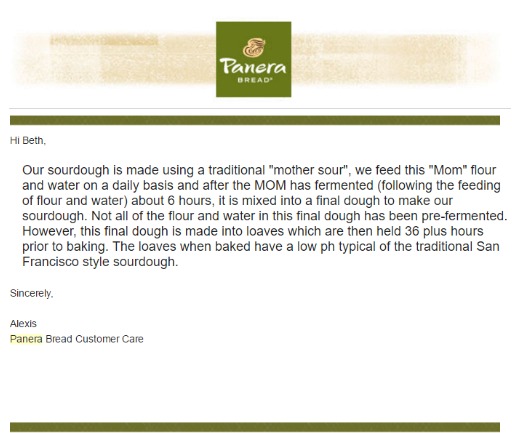
While this answer sounds promising, examining the ingredients of Panera Bread’s sourdough quickly identifies it as a fake. From the Panera website:
Unbleached Enriched Wheat Flour (Flour, Malted Barley Flour, Niacin, Reduced Iron, Thiamine Mononitrate, Riboflavin, [synthetic] Folic Acid), Water, Salt, Yeast (Yeast, Sorbitan Monostearate, Ascorbic Acid [GMO]), Dough Conditioner (Ascorbic Acid [GMO], Microcrystalline Cellulose [refined wood pulp], Corn Starch [GMO])
Not only is the Panera sourdough a phony, but it also contains yeast, wood pulp, and GMOs. It is also fortified with synthetic vitamins including dangerous folic acid (instead of natural folate).
At least The Essential Baking Company’s fake sourdough described earlier in this article is organic. This means no GMOs or other toxic ingredients.
As you can see, the phony sourdoughs on the market today range from simply misleading to downright dangerous. Best to avoid them all and get the real thing!
Do you currently buy an authentic sourdough? If so, what are the ingredients and what is the brand?








I have noticed some commercial sourdough breads have some kind of vinegar listed on the ingredients, which otherwise look fine, according to your rules. Is this to make the bread taste sour without the proper amount of fermenting time, or something? A sourdough breads made with vinegar “fake?”
I don’t consider using vinegar fake … sour leavening flour just before baking is a legitimate method and uses ACV, whey or lemon juice.
Why do all the types of sourdough Bread from Heaven made with apple cider vinegar? For the sour taste? That’s what the fermentation is for. I have never heard of anyone making real sourdough bread with vinegar.
My mistake! I think I had been toggling back and forth from the link showing the ingredients for the rustic sourdough. I didn’t know “unbleached wheat flour” and “unrefined” were syonymous for whole-grain. You would think the product label would be the same as on their site, so thanks for enlightening me!
Hi Sarah,
After reading this post about real sourdough bread, I ordered some from Organic Bread of Heaven. I, too, got the rustic sourdough as well as the sourdough bagels. However, I feel compelled to let you know that the label on my package doesn’t read the same as yours. Mine says “organic unbleached wheat flour, organic sourdough culture, organic apple cider vinegar, water, sea salt.” There is no mention of wheat bran so I don’t consider my bread to be whole grain. That being said, it’s still good and made with minimal ingredients. And I especially liked that it’s comparably priced to regular grocery store bread. I will definitely be buying again.
Glad you liked the bread! Our family loves it 🙂 Not sure why you think the ingredients on my bread said “wheat bran” …I’ve never mentioned this as far as I can recall. The wheat flour is unrefined, hence the bran is in there already, so no need to add it back in as a separate ingredient. On the website they mention that the unbleached wheat flour has the bran but the bread label just says unbleached wheat flour which means the same thing. Hope that helps.
People are getting smarter about sourdough bread and see the effect on their body from the store bought breads. Thanks to documentaries on Netflix like Cooked episode: Air
The only bread I ever eat the last 8 years…. my digestion is better and inflammation gone….of course I bake them and spreading the baking love….only flour, water, salt.
A handy guide to spotting what we at the Real Bread Campaign call sourfaux, ie products marketed as sourdough but made using baker’s yeast and/or one or more food additive.
GMOs are not toxic.
Lots of studies say otherwise! https://www.thehealthyhomeeconomist.com/from-sterility-to-stomach-holes-11-scientific-reasons-why-you-must-avoid-gmos-now/
Seems I can’t trust anyone when it comes to bread. Can only eat sourdough bread…get Panera bread bowl( minus soup, get that on the side) and “sourdough” loaf at grocers. Now find out neither are true sourdough!! Sheesh!
Hi Sarah…thank you for this information. I clicked on the link for the sourdough that you recommended but there are 8 ingredients including sweetener and yeast. Have they changed since you posted. I’m trying to find a true sourdough but this seems contrary to what you’re saying. Thank you for your time.
The true sourdough bread I linked to does not have sweetener or yeast in it! https://www.ovenfreshdelivery.com/products/rustic-sourdough/?aff=37
Ingredients: Organic Unbleached Wheat Flour, Organic Unbleached Wheat Flour w/bran, Organic Fresh Sourdough Starter, Water, Organic Apple Cider Vinegar, Sea Salt
Winco sells a sourdough bread. Ingredients states
Naturally aged starter. Do you have any info on this bread?
I haven’t ever heard of it before.